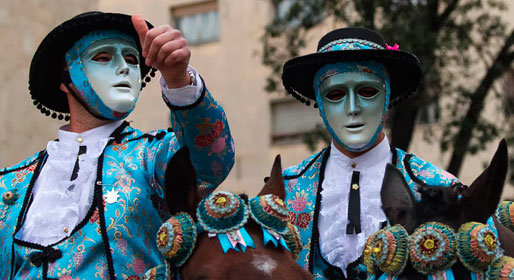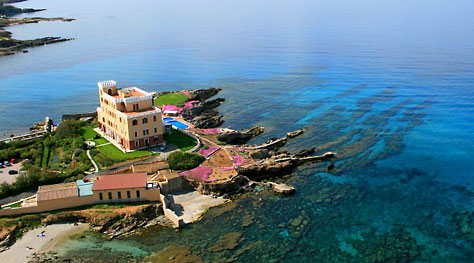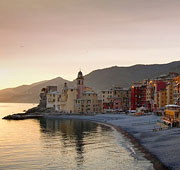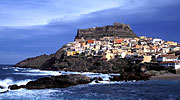Sardinia: Eyes (and Ears)
A Journey of the Senses into the Heart of Sardinia
Been to Italy? Sardinia is different. Graffiti on abandoned houses in the center of this hardscrabble rock tells you so emphatically, "Sardinia is not Italy!"
Saint's Days and Stews
Imagine deepening shadows stretching across irregular paving stones of a nearly empty piazza. Folks peer out of little doors to determine if it's the right time to make an appearance at their yearly saint's day festival. We have arrived, you see, at the beginning, the time to start celebrating the seasonal bounty according to notes stuck to lightposts and printed on colorful festival posters--a time which has absolutely no significance to the locals. We will come to call the real time "Sardinia time." For you: add two hours, more or less.
Thus we are alone in this Sardinian square except for a man who sits beside a steaming pot balanced over a fire built right on top of the paving stones. It's obvious by his body language that he's been there since his stew started simmering, perhaps as early as the remembered cool of morning.
My friend Antonio edges over toward the pot until his face is enveloped by the steam. "Ah, Luigi," he announces, "favas!" He pokes a finger in and licks it clean.
Antonio explains, "It's ready. They are just waiting for the people." He turns to the man in the chair who rises slowly, wobbly, a hand-carved spoon clutched tightly in his enormous hands. There is a flurry of another language, oddly packed with grunts and strange "u" sounds tacked to the end of words where other vowels usually appear.
I can't follow the unfamiliar babble but notice the man start trolling through the favas and pig parts with his spoon, quite carefully, as if he's lost his wedding ring amongst them. After a few minutes his eyes light up. He jabs the spoon into the bubbling depths. A little grin indicates he has found what he is looking for. I am happy for him.
He carefully lifts and shakes the spoon until a somewhat gelatinous pig part is all that remains cradled in it.
Then he offers it to me.
It is piggy/fragrant. It begins to melt in my mouth, leaving a bit to chew and savor. Everything about it is new and exciting--the flavor, the texture, the amazing "perfume" from exotic mountain herbs broken down into the stew.
Antonio leans over and in an excited whisper informs me of my importance to the man and his stew. "He likes you. He has offered you a great honor, the greatest honor in this part of Sardinia--the ear!"
And all I had to do was stand there playing dumb.
Contrasts and Contradictions
Sardinia is a land of contrasts and contradictions. Broad beans, favas, are an island specialty worth celebrating. They are loved by a great many of the natives. But for many others they're discomforting, if not deadly. A considerable portion of the population suffers from Favism, a hereditary condition in which red blood cells break down when the body is exposed to broad beans, which can occur even when breathing the pollen. Favism in Sardinia occurs so often that it is tested for in infants.
Hang around long enough and you will notice that there is no greater contrast than what tourist may find between the Costa Smeralda, the Emerald Coast, and the inland territories, what anthropologists might define as the "real" Sardinia. Yes, you can go to a resort on the celebrated Costa Smeralda where you'll be royally fawned over; you can shell out $15 for a beer and have your every need catered to in an environment that is as beautiful as you can imagine.
Or, you can go inland to a parched landscape and see how people have cleverly dealt with their relationship with the hostile environment over thousands of years. The beer is cheaper, the travel more difficult. The train is slow. The festivals are spectacular. The language is often incomprehensible, the food tasty. The festivals, furthermore, are for them, not you, the tourist. Which, of course, makes them far more interesting.
Besides, you never know when the pig part of honor will be bestowed upon you--which makes a far better story to tell your friends than one featuring the absurdity of spending $15 for a bottle of beer.
Ancient Architecture
If you set off in search of visual wonderment, you won't go wrong in Sardinia. The island is dotted with "nuraghi" - towers built of enormous, rough-hewn stones several stories high. Even older than most nuraghi are the "sacred wells" which feature stone work so precise you won't be able to fit a piece of thin paper between the courses of stone. "Giants Tombs" hold the dead inside gargantuan structures reminiscent of bulls horns, or, when viewed above, a uterus. You won't have trouble finding unique examples of very ancient architecture - just drive! There is even a ziggurat in Monte d'Accoddi.
Historic Festivals
But if you're more inclined toward action events in your quest to discover a destination's history, Sardinia has exactly what you crave.
L'Ardia in Sedilo
Each year in July, Constantine's victory over Maxentious at Rome's Mulvian Bridge in 312 is reenacted in the little town of Sedilo, a three day event called L'Ardia. The basics are this: the man taking the role of Constantine (a saint in Sardinia), having been the recipient of a special act of God, chooses two flag bearers to be his faithful companions. They will be chased in the race by everyone who lives near Sedilo and owns a horse. The dirt and gravel roads are treacherous, the gate into the compound of the Sanctuary of Saint Constantine allows but three competing horses at a time with grave consequences for a misstep, and the horses are held back from the onlookers by men shooting rifles. As if that wasn't enough, Constantine's flag bearers are allowed to do anything they wish to keep the others back, including knocking them off their mounts using the flagpoles. They must be successful at bringing their man home, since the whole town's fate for the next year will rest upon Constantine's victory. It's no wonder Sardinian riders are held in high regard when hired to ride in the more celebrated and far less dangerous Palio di Siena. It's a piece of cake after L'Ardia.
After the race they start the fires and there is food. Have the eel, a Sardinian specialty. But don't stay up too late, the real race is run early the next morning, after the riders themselves have stayed up all night imbibing.
Carnival in Oristano
If you like your activities fueled by skill rather than testosterone and booze, try to be near Oristano at Carnival time, when horses again figure in an ancient jousting competition in which costumed riders race at full gallop while trying to skewer a star hanging over the street. Sa sartiglia will amaze and astound you. Bear in mind that the chosen leader of this event, Su Componidori, has been sewed into his outfit by young girls, including the mask that hides his real identity. He will emerge to bless the competitors and onlookers with 'sa pippia de maiu', a clutch of violets and periwinkles.
Endless Discovery
With that I am out of space. I haven't been able to tell you of the artist who makes rocks sing, the 93 year old woman who still makes traditional lace without the aid of glasses, Mussolini's mines, or the 'suckling pig wrapped in myrtle leaves you must have for dinner.
I will, however, leave you with one bit of advice: approach Sardinia like you should approach all travel, like a child with eyes wide open. What you might see on an island the size of Wales or West Virginia will likely astound and amaze you.
Our Insider is
Could you be our next Insider? Share your love of Italy by contributing to ItalyTraveller! See how!





















